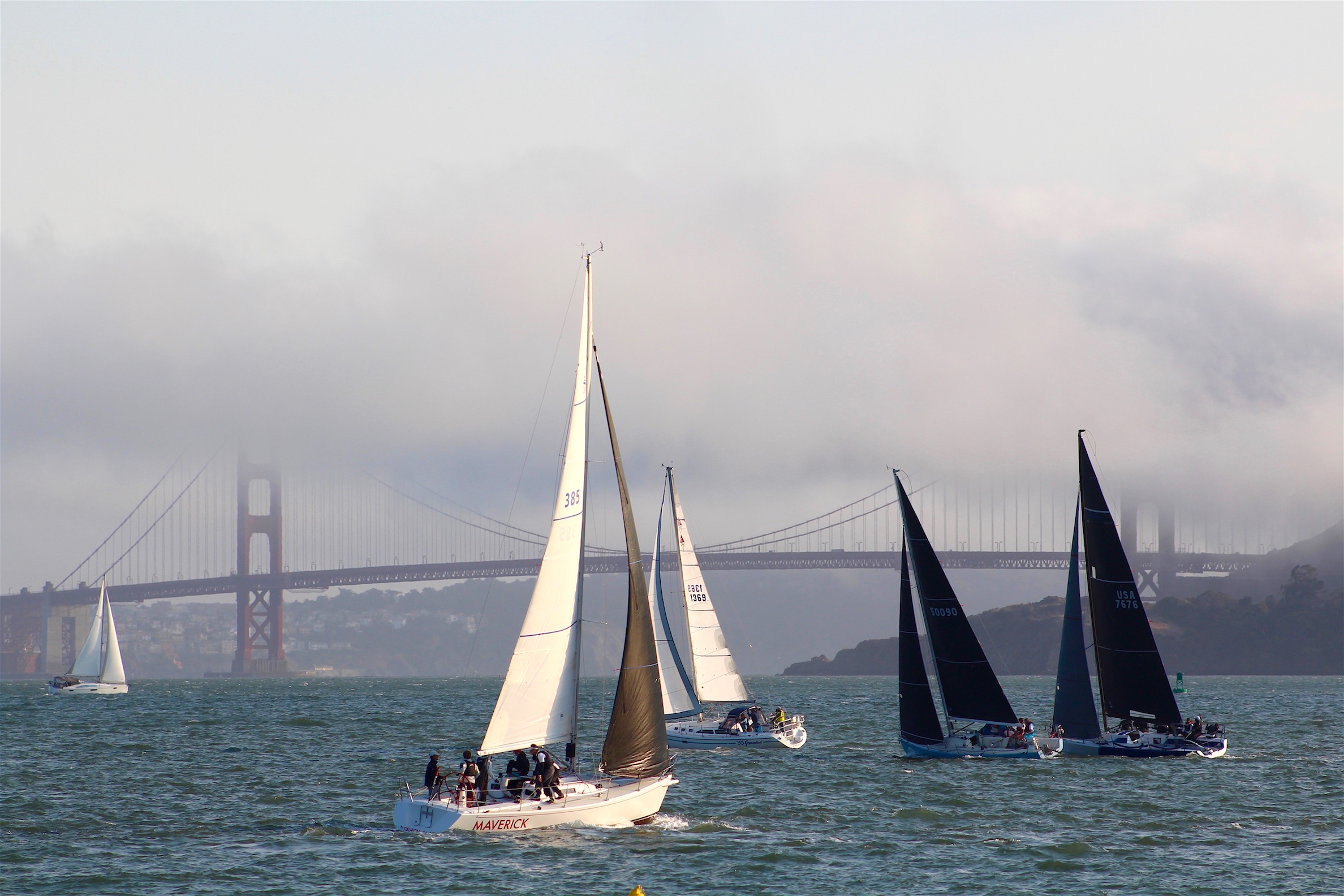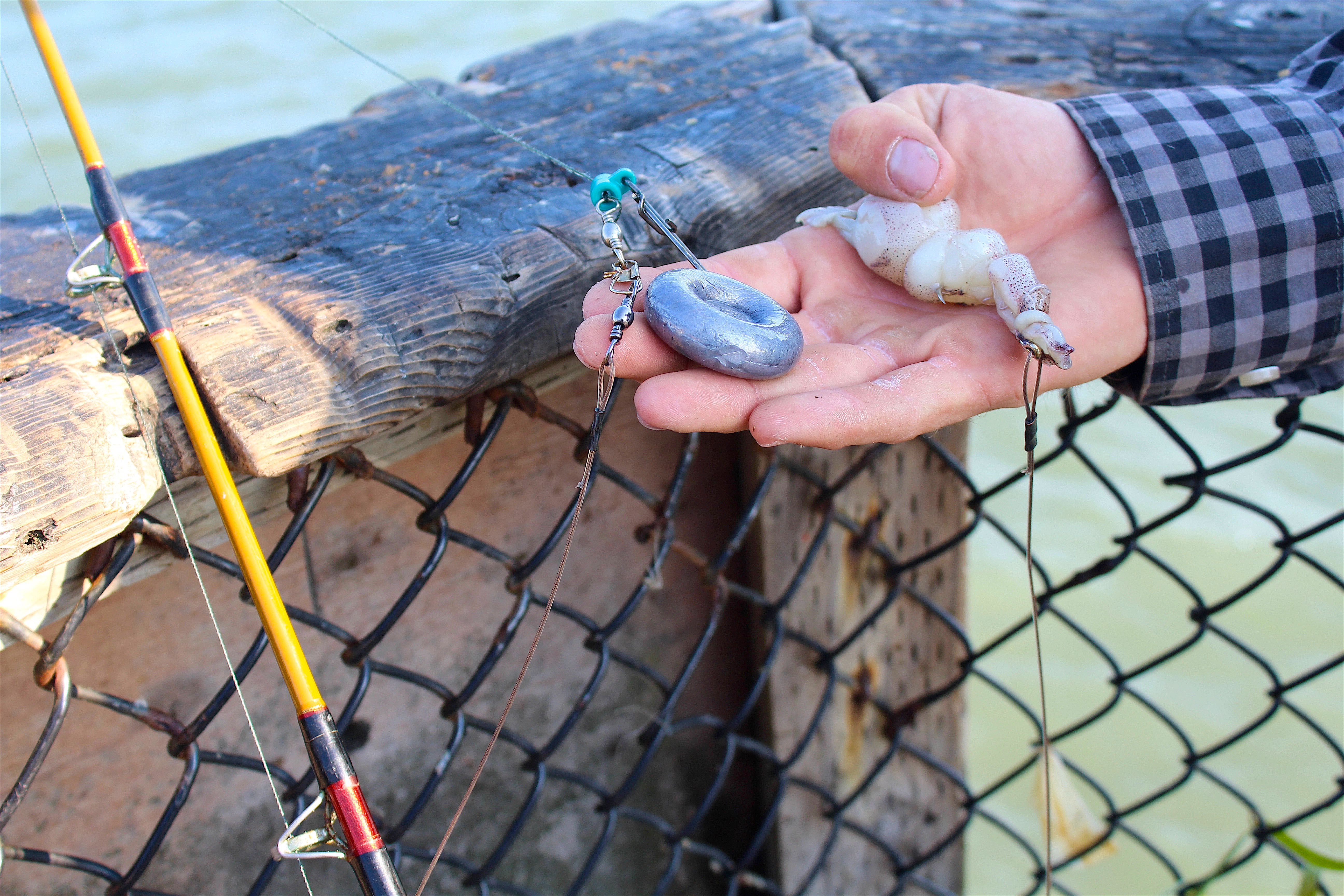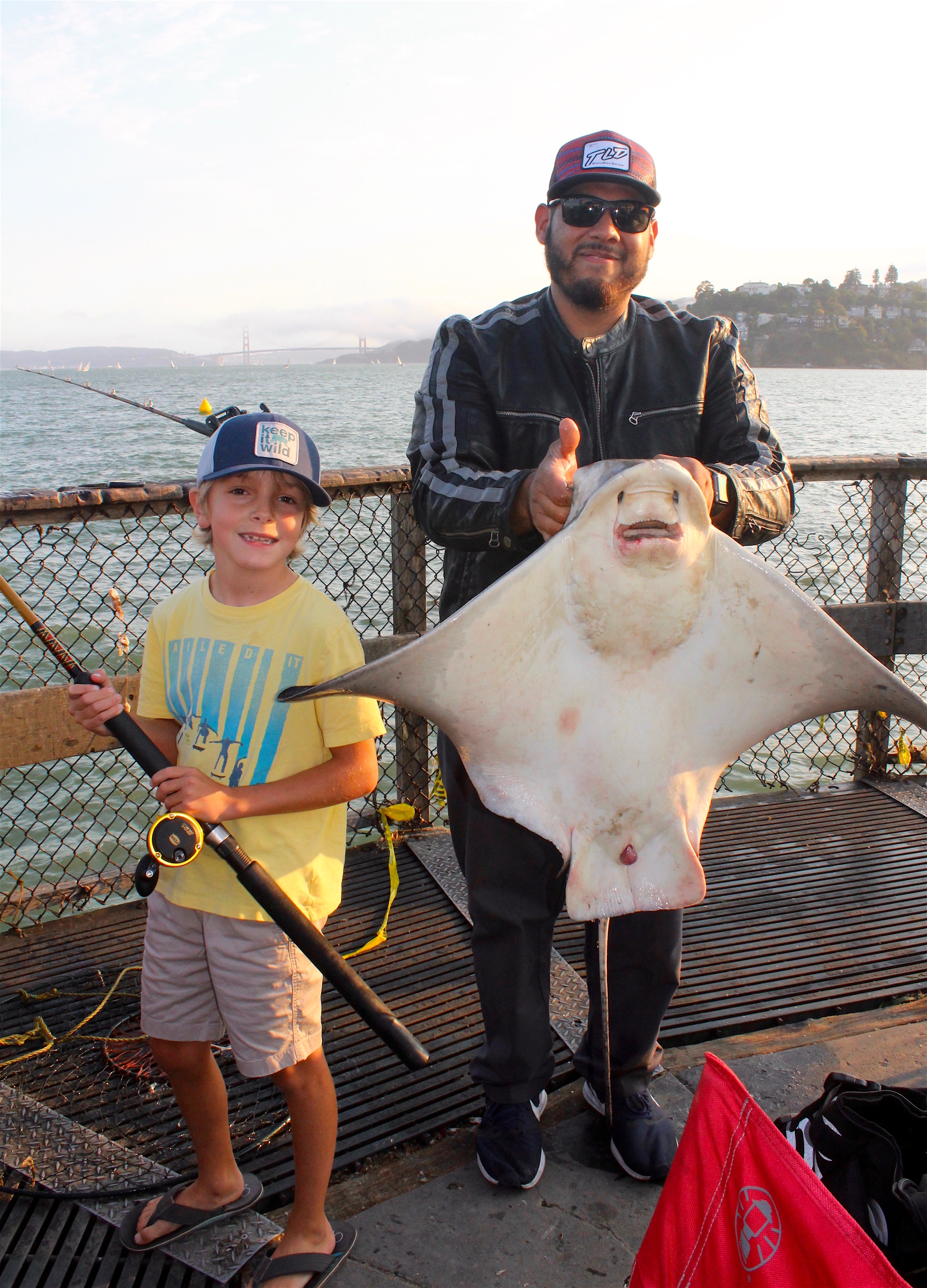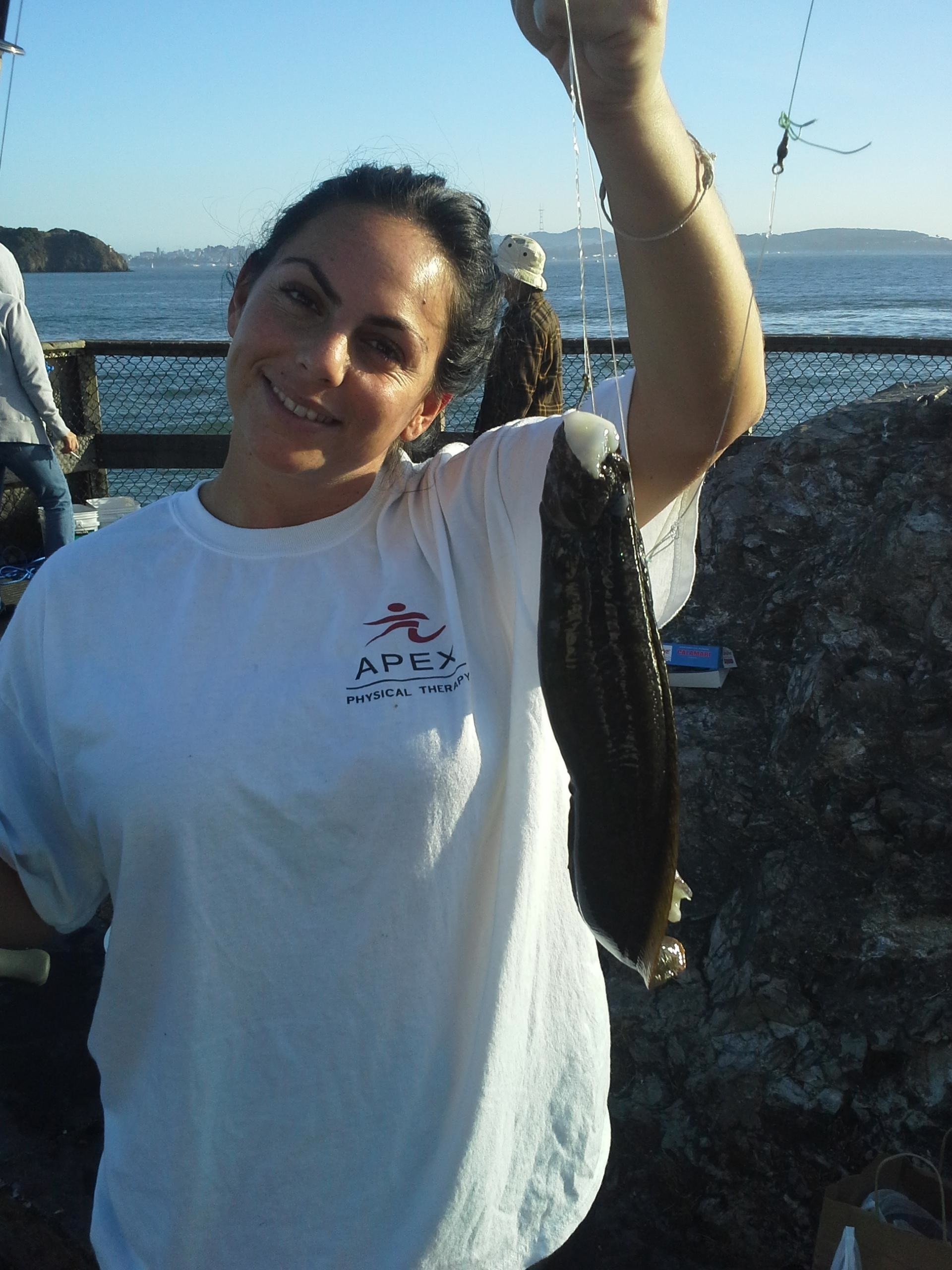Public Pier — No Fishing License Required
When opened in the early 1960s, this pier was “dedicated to all girls and boys under 16 years of age who love to fish.” In fact, no one was supposed to fish on the pier who was over the age of 15 (although many adults did and no one really seemed to object). Today it seems to be shared by anglers of all ages. The pier itself is both tiny and unique. The entire pier is only 75 feet long and most of this is a walkway which extends from the rocky shoreline to a circular fishing platform built around Elephant Rock. Hardly more than a dozen anglers will fit on the platform but fishing here can be quite good. In fact, fishing here is among the best to be found among Bay Area piers. If the pier was larger, and provided space for a greater number of anglers, it might rate among the best in the state, at least for several species.

The Golden Gate Bridge
Environment. The pier sits at the eastern end of Tiburon’s Shoreline Park, a narrow green belt that sits between Paradise Drive and the waters of San Francisco Bay. The park and its paths provides some absolutely great views of San Francisco, the Golden Gate Bridge, and the yachts and sailing craft that call Tiburon and Belvedere Island their home. The park starts at the business district and ends at Tiburon Point.

On Tiburon Point sits this small pier, a pier that juts just a short way out into Raccoon Strait. Water depth around the pier averages only about fifteen to twenty feet (and changes with the tides) but the bottom drops rapidly away. The strait itself is a deep-water channel that reaches a depth of 160 feet. one of the deepest channels in San Francisco Bay. As such, its depth is only exceeded by that of the Golden Gate Channel that reaches 313 foot deep. One result is that strong currents are common, both incoming from the Gate and outgoing to the Gate; and the currents can require quite a bit of lead to hold bottom. The bottom itself is primarily sand and mud but there are considerable rocks that can grab tackle, especially if you make a cast far out from the pier. Be warned.
Across the strait is Angel Island; adjacent to the pier is Belvedere Cove, upshore is Tiburon’s business district and ferry launch to Angel Island.

Fishing Elephant Rock is, for the most part, like rock fishing. A drop straight down around the rock can provide excellent fishing for brown rockfish, blackperch and striped seaperch most of the year, rubberlip seaperch and rainbow seaperch mid-winter to spring. Crabbing with nets almost always yields at least a few keeper-size rock crabs.

Casting away from the rocks, and fishing on the bottom, will often yield white croaker (kingfish), striped bass (in the fall), or sharks and bat rays. Fishing on the surface often yields nice strings of jacksmelt. Winter time, December through February, can see huge schools of Pacific herring massed around the inshore rocks. When the herring enter local waters and begin to spawn, sturgeon will be close behind and eager to vacuum up some of the tasty eggs.

Tiburon’s main business district sits just up the shore from the pier
Fishing Tips. Best bait here is fresh mussels or pile worms baited on a size 6 or 8 hook. You should fish directly under the pier, in and around crevices in the rock. Watch your line and bait, keep the line taunt, and strike as soon as you feel a nibble. If a perch strikes and you miss it simply continue to fish in the same spot, the perch will return. You will, using these small size hooks and this type of bait, also catch a number of other small fish. Most of these unfortunately will be too small to keep or use but they can provide fun for young anglers. Commonly caught fish are small brown, blue, black, and grass rockfish, cabezon, kelp greenling, kelpfish, fringeheads and a few Irish lord.

Angel Island and its cove (along with a pier) sits just across the strait

Another good spot for perch is the water in front of the Caprice Restaurant (which requires a short but very accurate cast since the picture windows would be pretty expensive to replace); pile worms sometimes produce good-sized rubberlip perch in that area.

Black (or buttermouth) Seaperch caught by Gudawg
For jacksmelt, use a multi-hook leader loaded with three size 8 or 6 hooks baited with small pieces of pile worm or shrimp. Use a float to keep the line just under the surface of the water. Most of my best catches of these fish have been on an incoming tide when the current was sweeping the water past the rock. Schools of jacksmelt often seem to hang twenty or thirty feet past the rock and will hit the baits if they are in the correct mid-depth location. Many of the jacksmelt that frequent these waters seem to be of the gargantuan variety, fish 15-17 inches long that somehow have the mistaken idea that they are trout (or maybe baby tarpon). They fight hard and occasionally even jump. Some of the locals try small spoons and spinners for the large smelt and have a blast on ultra-light tackle. The most common lures seem to be Mepps and Roostertail spinners as well as light, quarter-ounce spoons.

Rubberlip Seaperch
Casting away from the pier can yield kingfish and brown rockfish by using small pieces of anchovy, shrimp or squid.

Tiburon in Spanish means shark and it’s an appropriate name for the town since a lot of sharks are in the local waters. The pier is noted for leopard sharks, often big leopard sharks, as well as bat rays, often big bat rays. However, given the depth of the strait even bigger sharks are in the vicinity.
On one visit to the pier I ran into Travis and Jason who were fishing for and hoping for a 7-gill shark.They were regulars who showed me picture after picture of good-sized sharks and rays including some nice 7-gill sharks. They said it was always best to fish an outgoing tide and their gear was always the same. A fish-finder-type rig with a long wire leader, strong, size 4/0 hooks, and a torpedo sinker of anywhere from 4-8 ounces depending upon the current. Bait was typically a whole wrapped squid (that was generally impervious to the crabs). When a fish bit a good strike was needed and then the goal was to get the fish coming toward the pier, and up and away from the rocks, as soon as possible.



Although they only stayed a few hours, and didn’t get their 7-gill, they did manage to hook and land several bat rays and in one case handed the rod off to a youngster who managed to catch his first bat ray.



A happy young angler with his first bat ray — with a lot of good coaching from Juan
As mentioned, this is an excellent pier for leopard sharks and if you bring a light you can usually fish into the night. A long cast straight out from the end (or slightly to the left) seems to provide the best water for the larger sharks and bat rays (called stingrays by almost everyone). I have had my best luck on an incoming tide but have seen both sharks and rays landed on every tide. Be sure to bring a net with you since many of the sharks and rays are pretty good size, far too big to hand line up onto the pier. Also, remember to bring extra sinkers and leaders since there are a lot of rocks to grab hold of your riggings.

Leopard Shark caught by Red Fish (Robert Gardner)

Leopard shark

Bat Ray
You can hook fairly large fish straight down by the rock. One mid-June trip to this pier nearly resulted in the capture of a large monkey-face eel and the story of that fish can teach a lesson. By investigation, I had found a deep-water hole that curved under the rock. Several drops into the hole saw repeated taps on the bait but no hookups. Thinking it was a perch, I dropped a size 6 hook baited with pile worms into the hole. I had an immediate bite! A quick jerk hooked the fish and also prevented it from getting back into any crevice. With the bend of the pole I knew I had a good size fish but at first I had no idea as to what I had hooked. Nevertheless, after a short fight, I had the fish to the top and it was an ugly-looking monkey-face eel around 2 feet in length that twisted and turned the way eels normally do. Unfortunately, I was using my light pole rigged with 6-pound test line and I felt I might lose the fish if I tried to lift it up to the pier. Instead, I tried to gaff it with my treble-hook pier gaff (which really wasn’t too bright of an idea considering the shape of the fish). I held the pole with one hand and tried to gaff it with the other. Just about the time I was ready to gaff it, Mr. Ugly gave a jerk, the gaff hit the line, the line snapped, and the fish said adios.
Although I had lost the fish, I made two subsequent trips to the pier in hopes of rehooking the eel. I knew that many fish will stay in a favorite hole for months or even years depending upon the type of fish, and eels such as monkey-face eels and wolf eels are prime examples of fish with this trait.

A monkeyface eel (but not mine)
I returned in mid-July and caught only a few small perch. I returned again in mid-August, just three days shy of two exact months. Two drops into the hole quickly resulted in two fish, a medium-sized brown rockfish and a black seaperch. Action then centered on a school of large jacksmelt that were attacking pile worms just under the surface of the water. Finally, I dropped one more pile worm-threaded hook down into the hole. Just as two months before, I had a hard strike and soon saw the twisting and turning body of an eel thrashing at the surface. Nervous that I would once again lose the fish, I worked the fish completely around the pier and then up along the pier to the shoreline where a helpful angler netted the monkey-face eel for me (yes, I had brought a net this time). It was 24 1/2-inches long and I am convinced to this day that it was the very same fish I had hooked two months before (since these types of eel are rare off of piers, especially two of the same size, from the same hole). Remember, if you lose a good fish in a favorite hole, return and fish that hole. It may be several hours, days or even months later but unless the fish has been caught by someone else, or used as food by a fellow denizen of the deep, there is a good chance the fish will still be using the hole for its home base.

Blackperch
The variety found here is one of the reasons I like this pier, you just never know what you might catch. My best day, as far as species, was on October 11, 1999 when I took ten different species— jacksmelt, walleye surfperch, dwarf perch, cabezon, shinerperch, kelp rockfish, black seaperch, striped seaperch, brown rockfish, and kelp greenling, all in a short three-hour visit.

Grass Rockfish
In the fall, during the World Series bite, the nearby shoreline is a favorite place for striper fisherman to cast lures for stripers, some of which reach very impressive size. I see no reason why anglers fishing from this pier shouldn’t have similar success.
As mentioned, the area can see quite a few sturgeon when the herring are in the spawning mood. Sturgeon rigs can be cast out here and when baited with masses of the eggs should yield a few sturgeon. If you can’t procure any of the eggs (and they should be available at local shops) try a slab of herring itself or switch to the old standbys—ghost shrimp, mud shrimp or grass shrimp.

Cabezon
The Pier Rats Speak
Date: June 10, 2000; To: PFIC Message Board; From: Fish Fool; Subject: Elephant Rock Pier
Fellow Pier Rats: Went to The Rock today, got there at 3:20 and fished until about 7:00. After about 15 min., I hooked into something. I had not even finished getting out all the poles. The fight was on; it didn’t feel too big, but too bad. After a short fight on my brand new reel (my Graduation Gift from my family) we got in the Bat ray that went about 15 pounds. We netted it and let it go back to her family. Before we had that one in we had another one on. Had to have my Mom fight the fresh one for a little bit until I could get the other Ray back into the wild. Then with the small Ray back, I could fight the new Ray that was on (not that my Mom can’t fish). After a longer fight then the first, we got it in, had a hard time to get it into the net because the wing was hooked. Finally got it in and after a fast picture we let it go. 60-70 #s? That was all for about an hour. I still didn’t have all my poles out.

This our favorite pier- have caught huge stingrays and leopard sharks. We crab snare here and get some really nice Red rock crabs!!! beautiful view, such nice people as well!!
Such an inspiring read! The detailed experience of fishing at Elephant Rock Pier is captivating.
arabic poems. Enjoy reading and listening to the best Arabic poems with explanation! Discover the most famous Arab poets and the beauty of the Arabic language through poetry.